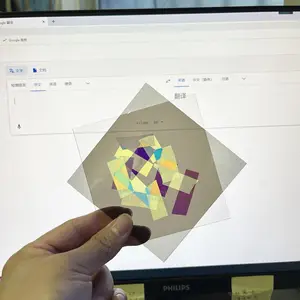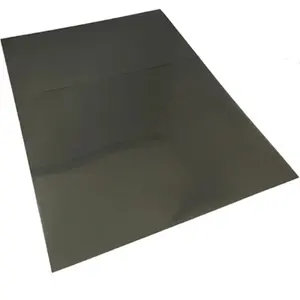What is High-quality Polarizer Film
High-quality polarizer film is an essential component in the realm of modern optical technology. It is a type of film that is applied to various display devices to enhance the clarity and contrast of the images rendered on the screen. The primary function of a polarizer film is to filter out certain light waves, such as glare and reflections, which can be particularly problematic in outdoor or brightly lit environments. By doing so, the film helps to improve the visibility of the displayed content, making it easier for the viewer to see the image with greater detail and depth.
This specialized film works on the principle of polarization. Light waves travel in various directions, and when they strike a surface, they reflect or refract in different ways. Glare occurs when the reflected waves are scattered in multiple directions, making it difficult to see the image clearly. By using polarizer film, the light waves are aligned in a specific direction—usually horizontally—and this alignment reduces the amount of reflected light. The result is a clearer image that can be viewed from a wider angle without distortion or interference.
High-quality polarizer films are designed for professionals who require a high degree of visual clarity and minimal distortion. They are commonly used by photographers, videographers, and professionals in fields such as automotive, marine, and outdoor electronics where visual clarity is paramount. However, with the growing popularity of consumer electronics and the need for enhanced screen visibility, high-quality polarizer films are also becoming more prevalent in devices like smartphones and tablets for the average consumer.
Types of High-Quality Polarizer Film
High-quality polarizer films come in various types, each with distinct features catering to specific needs and applications:
-
Linear Polarizer Film: This common type of polarizer film allows light waves to oscillate in a single plane. It is widely used in photography and LCD screens to reduce glare and improve visibility.
-
Circular Polarizer Film: Unlike linear polarizers, circular polarizers can maintain the same level of polarization regardless of the angle at which the light enters. They are essential for 3D movies and displays where the viewer's eyes must distinguish between different images seen through the polarizer and lenses.
-
Anti-Reflection (AR) Polarizer Film: These films not only reduce glare but also minimize reflection off the lens surface, increasing clarity in brightly lit environments.
-
Hard Coated AR (HAR) Polarizer Film: With a hardened surface coating, these films provide added durability and scratch resistance for outdoor or rugged applications such as automotive or outdoor electronics.
-
Hydrophobic AR (HAR) Polarizer Film: Hydrophobic AR polarizer films repel water, dust, and oil, making them suitable for use in outdoor or automotive situations where they might be exposed to the elements.
How to choose High-quality Polarizer Film
Selecting the right High-Quality Polarizer Film for your business involves considering several factors that impact the performance of the final product. As businesses on Alibaba.com often purchase these films for use in their own products or for resale purposes, understanding these considerations is crucial.
Firstly, assess the application's requirements: what type of polarizer film does your product need? If you're manufacturing sunglasses or goggles for outdoor use, you'll likely need TAC polarizing films for their durability and UV-protection. For indoor use with electronic displays, one might consider acrylic polarizing films due to their high clarity and anti-glare properties.
Consider the viewing angle: some applications may require a specific angle of light transmission. TAC polarizing films maintain their effectiveness across a wide range of angles, making them suitable for varied applications.
Additionally, factor in the material quality: high-end applications such as photography filters may demand more expensive materials with superior optical properties. On the other hand, for everyday products like smartphone screens or car sun visors, a more cost-effective option might suffice.
Finally, customization is key for many businesses. If you require specific dimensions or customized support like ODM or OEM services, look for suppliers who can accommodate these needs.
About High-quality Polarizer Film on Alibaba.com
Alibaba.com stands as a pivotal marketplace connecting businesses worldwide with a vast selection of suppliers offering high-quality polarizer films. With its inception in 1999 as part of the larger Alibaba Group, Alibaba.com has since become an indispensable tool for small and medium-sized enterprises seeking specialized goods such as polarizing filters for their products.
The platform boasts an extensive network of suppliers providing a wide array of polarizer films tailored to meet various industry requirements. Whether you're looking for TAC (Triacetate), TPU (Thermoplastic Polyurethane), or PC (Polycarbonate) polarizers in sheet form or custom-cut sizes suitable for your specific application needs—Alibaba.com facilitates this by offering detailed product descriptions and supplier information so you can make informed purchasing decisions.
Moreover, Alibaba.com's commitment to streamlining global trade is evident through its user-friendly interface that supports multiple languages and mobile accessibility. The inclusion of services like Trade Assurance further reinforces buyer confidence by ensuring payment protection until delivery confirmation. With Alibaba.com's extensive product listings across diverse categories and its dedication to fostering secure transactions, businesses can confidently source the best high-quality polarizer films for their manufacturing processes or resale purposes.
Common FAQs for High-quality Polarizer Film
What are the main benefits of using a polarizer film?
Polarizer film reduces glare and reflections, which can improve visibility and color saturation, making it particularly beneficial for outdoor photography, driving, or any activity where these factors could be a distraction.
How does a polarizer film work?
A polarizer film works by filtering out or reducing the intensity of reflected light from surfaces like glass, water, or non-metallic objects, which can reduce unwanted reflections and enhance the saturation and clarity of photographs.
Can polarizer films be used with all types of lenses?
Polarizer films can be used with most lenses; however, it is essential to choose a filter that fits the filter thread size of the lens to ensure proper attachment and functionality.
Are there different quality levels of polarizer films?
Yes, there are different quality levels of polarizer films available, indicated by the material of the film (such as TAC or TAC polarized) and coatings that may offer better scratch resistance and optical properties.
What is the difference between TAC polarized film and TAC polarized film?
TAC polarized film is a high-quality option that offers better optical properties and is generally more durable than its TAC counterpart, making it suitable for professional or high-demand applications.
How do I choose the right polarizer film for my business needs?
Choose a polarizer film based on your specific business requirements, considering factors such as the film's material, optical properties (like transmission and clarity), coating type (like UV protection or anti-reflective), and whether it aligns with your company's sustainability goals.
Is it possible to get customized polarizer films for my company's products?
Many suppliers offer customized support including ODM and OEM services that allow businesses to tailor polarizer films to their specific application and branding requirements.
What should be considered when purchasing polarizer films for vehicles?
When purchasing polarizer films for vehicles, consider UV protection, heat insulation capabilities if it's for windshield applications, and the film's ability to reduce glare that might be experienced by drivers.
Are there eco-friendly options available for polarizer films?
Yes, some suppliers offer eco-friendly polarizer films made from biodegradable materials or employing less toxic chemicals during production. It's important to check with the supplier about their eco-friendly offerings.
Can polarizer films be used in lighting applications?
Polarizer films can be used in lighting applications to enhance contrast and reduce glare. However, it's essential to ensure that the film is designed for this use and has the proper light transmission properties required for safety and performance.
How do I maintain the quality of polarizer films during storage and use?
To maintain the quality of polarizer films during storage and use, keep them in a cool, dry place away from direct sunlight. Avoid bending or scratching the surface as this can damage the film's optical properties.










































 浙公网安备 33010002000092号
浙公网安备 33010002000092号 浙B2-20120091-4
浙B2-20120091-4